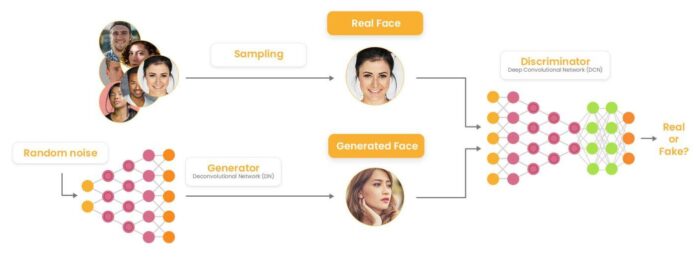Artificial Intelligence has significantly impacted content generation, from translating text into visuals to crafting art and animations, particularly in image synthesis. Generative AI models for image synthesis, such as Midjourney and DALL-E, have made this process simpler. These models are pivotal for creators and businesses, utilizing complex algorithms to produce realistic images that are tough or impossible to achieve through traditional methods.
Understanding generative AI models
Generative AI models are machine learning algorithms that can produce original content based on patterns derived from extensive training datasets. These models use deep learning methodologies to understand intricate patterns and distinctive features within the training data, leveraging this knowledge to create new data samples.
The applications of generative AI models span a wide spectrum, encompassing tasks like generating images, texts, codes, and even producing music. Among the most renowned variants of generative AI models lies the Generative Adversarial Network (GAN).
What is image synthesis, and what is its significance?
Generative models offer a range of applications, one of which involves synthesizing new images that resemble the data they were trained on. It is accomplished by utilizing deep learning algorithms that learn features and patterns from a large database of images. These models can correct any misleading, blurred, or missing visual elements in the images, resulting in realistic and high-quality images.
Generative AI models can enhance the quality of low-quality images to resemble expert-captured photographs, achieved by improving their clarity and fine details. Furthermore, these models can blend existing portraits or extract characteristics from various images to produce artificial human faces that resemble actual individuals closely.
The significance of generative AI in image synthesis lies in its capability to create unique and fresh images that have never been seen before. This holds significant implications for diverse sectors, such as product design, marketing, and scientific domains.
Notable among the various generative AI models for image synthesis are variational autoencoders (VAE), autoregressive models, and generative adversarial networks (GANs).
Generative AI models for image synthesis
Various generative AI models contribute to image synthesis, each showcasing its own strengths and limitations. Here, we explore some prominent generative AI models for image synthesis:
Generative Adversarial Networks (GANs)
Generative Adversarial Networks, commonly known as GANs, represent a highly popular category of generative AI models for image synthesis. GANs consist of two neural networks: a generator and a discriminator. The generator produces new images, while the discriminator evaluates their authenticity, distinguishing real from fake.
During the training phase, these networks train together through a technique known as adversarial training. The generator strives to deceive the discriminator, while the latter aims to differentiate between authentic and synthetic images accurately. This iterative process facilitates the enhancement of the generator’s ability to yield images that appear more and more genuine, making it challenging for the discriminator to tell if they are fake.
GANs have demonstrated remarkable achievements in producing images of superior quality and authenticity, with applications spanning computer vision, video game design, and painting. GANs excel in handling complex image features, generating detailed visuals with textures and patterns that can be challenging for other model types.
Variational Autoencoders (VAEs)
VAE is another type of generative AI model for image synthesis. VAEs comprise two parts: an encoder and a decoder. The encoder learns a condensed version of an input image, called latent space, while the decoder employs this condensed version to generate new images resembling the original input.
VAEs exhibit promise in generating high-quality images, especially when paired with techniques like adversarial training. They excel in producing visuals with intricate attributes like textures and patterns, capable of handling intricate scenes. Moreover, VAEs employ probabilistic processes in their encoding and decoding, enabling them to create diverse images from a single input.
Nonetheless, VAEs differ from GANs in their ability to create exceptionally realistic images, and their image generation process is lengthier as each image requires encoding and decoding. Despite these limitations, VAEs persist as a widely used model for image synthesis, proving effective across diverse domains, including medical imaging and computer graphics.
Autoregressive models
Autoregressive models, a type of generative AI model, are utilized for image synthesis. These models initiate the process with a seed image, gradually composing novel images by meticulously predicting the value of each pixel. This prediction depends on the values of the preceding pixels in the image. While the output of autoregressive models often boasts intricate and highly detailed imagery, it’s worth noting that their image generation pace is relatively slow due to the sequential nature of pixel generation.
It is important to acknowledge that despite their slow image generation process, autoregressive models have showcased their effectiveness in generating high-quality images with fine details and complex structures. This is particularly evident in applications like picture inpainting and super-resolution. It’s important, however, to highlight that when compared with GANs, autoregressive models may encounter challenges in yielding hyper-realistic images. Despite these challenges, it’s noteworthy that autoregressive models are popular for image synthesis across a spectrum of domains.
Final words
In the realm of creating images, the progress made by AI is genuinely impressive. It can turn text into captivating visuals and produce detailed artwork and animations, showcasing its notable capabilities, particularly in image synthesis. Tools like Midjourney and DALL-E have propelled this creative process, leveraging the potent capabilities of generative AI. These generative AI image models play a pivotal role for both individual creators and businesses, employing sophisticated algorithms to generate realistic images that conventional methods struggle to replicate swiftly. As a result, they are reshaping various sectors, including art, design, medicine, and entertainment, offering astonishing creations, aiding diagnostics, and enhancing immersive experiences. All these advancements underscore the increasing demand for top-notch AI development services.







